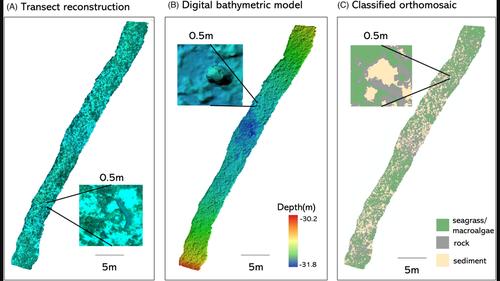当前位置:
X-MOL 学术
›
Remote Sens. Ecol. Conserv.
›
论文详情
Our official English website, www.x-mol.net, welcomes your
feedback! (Note: you will need to create a separate account there.)
Structure-from-motion photogrammetry demonstrates that fine-scale seascape heterogeneity is essential in shaping mesophotic fish assemblages
Remote Sensing in Ecology and Conservation ( IF 3.9 ) Pub Date : 2022-07-19 , DOI: 10.1002/rse2.290 Denise J. B. Swanborn 1, 2, 3 , Paris V. Stefanoudis 1, 3 , Veerle A. I. Huvenne 4 , Simon J. Pittman 5, 6 , Lucy C. Woodall 1, 3
Remote Sensing in Ecology and Conservation ( IF 3.9 ) Pub Date : 2022-07-19 , DOI: 10.1002/rse2.290 Denise J. B. Swanborn 1, 2, 3 , Paris V. Stefanoudis 1, 3 , Veerle A. I. Huvenne 4 , Simon J. Pittman 5, 6 , Lucy C. Woodall 1, 3
Affiliation

|
Benthic components of tropical mesophotic coral ecosystems (MCEs) are home to diverse fish assemblages, but the effect of multiscale spatial benthic characteristics on MCE fish is not well understood. To investigate the influence of fine-scale benthic seascape structure and broad-scale environmental characteristics on MCE fish, we surveyed fish assemblages in Seychelles at 30, 60 and 120 m depth using submersible video transects. Spatial pattern metrics from seascape ecology were applied to quantify fine-scale benthic seascape composition, configuration and terrain morphology from structure-from-motion photogrammetry and multibeam echosounder bathymetry and to explore seascape–fish associations. Hierarchical clustering using fish abundance and biomass data identified four distinct assemblages separated by the depth and geographic location, but also significantly influenced by variations in fine-scale seascape structure. Results further revealed variable responses of assemblage characteristics (fish biomass, abundance, trophic group richness, Shannon diversity) to seascape heterogeneity at different depths. Sites with steep slopes and high terrain complexity hosted higher fish abundance and biomass, with shallower fish assemblages (30–60 m) positively associated with aggregated patch mixtures of coral, rubble, sediment and macroalgae with variable patch shapes. Deeper fish assemblages (120 m) were positively associated with relief and structural complexity and local variability in the substratum and benthic cover. Our study demonstrates the potential of spatial pattern metrics quantifying benthic composition, configuration and terrain structure to delineate mesophotic fish–habitat associations. Furthermore, incorporating a finer-scale perspective proved valuable to explain the compositional patterns of MCE fish assemblages. As developments in marine surveying and monitoring of MCEs continue, we suggest that future studies incorporating spatial pattern metrics with multiscale remotely sensed data can provide insights will that are both ecologically meaningful to fish and operationally relevant to conservation strategies.
中文翻译:

运动摄影测量结构表明,精细尺度的海景异质性对于塑造中光鱼类组合至关重要
热带中光珊瑚生态系统 (MCE) 的底栖成分是多种鱼类组合的家园,但多尺度空间底栖特征对 MCE 鱼类的影响尚不清楚。为了研究细尺度底栖海景结构和大尺度环境特征对 MCE 鱼类的影响,我们使用潜水视频样带调查了塞舌尔 30、60 和 120 米深度的鱼类群落。海景生态学的空间格局指标被用于从运动摄影测量和多波束回声测深法中量化细尺度底栖海景组成、配置和地形形态,并探索海景-鱼类关联。使用鱼类丰度和生物量数据的层次聚类确定了四个不同的组合,按深度和地理位置分开,但也受到精细海景结构变化的显着影响。结果进一步揭示了组合特征(鱼类生物量、丰度、营养群丰富度、香农多样性)对不同深度的海景异质性的可变响应。具有陡坡和高地形复杂性的地点拥有更高的鱼类丰度和生物量,较浅的鱼类组合(30-60 m)与珊瑚、碎石、沉积物和具有可变斑块形状的大型藻类的聚集斑块混合物呈正相关。较深的鱼类组合 (120 m) 与地势和结构复杂性以及底层和底栖覆盖物的局部变异性呈正相关。我们的研究证明了空间格局指标量化底栖成分的潜力,配置和地形结构来描绘中光鱼类栖息地协会。此外,事实证明,结合更精细的视角对于解释 MCE 鱼类组合的组成模式很有价值。随着海洋调查和 MCE 监测的不断发展,我们建议未来将空间格局指标与多尺度遥感数据相结合的研究可以提供对鱼类具有生态意义并且与保护策略在操作上相关的见解。
更新日期:2022-07-19
中文翻译:

运动摄影测量结构表明,精细尺度的海景异质性对于塑造中光鱼类组合至关重要
热带中光珊瑚生态系统 (MCE) 的底栖成分是多种鱼类组合的家园,但多尺度空间底栖特征对 MCE 鱼类的影响尚不清楚。为了研究细尺度底栖海景结构和大尺度环境特征对 MCE 鱼类的影响,我们使用潜水视频样带调查了塞舌尔 30、60 和 120 米深度的鱼类群落。海景生态学的空间格局指标被用于从运动摄影测量和多波束回声测深法中量化细尺度底栖海景组成、配置和地形形态,并探索海景-鱼类关联。使用鱼类丰度和生物量数据的层次聚类确定了四个不同的组合,按深度和地理位置分开,但也受到精细海景结构变化的显着影响。结果进一步揭示了组合特征(鱼类生物量、丰度、营养群丰富度、香农多样性)对不同深度的海景异质性的可变响应。具有陡坡和高地形复杂性的地点拥有更高的鱼类丰度和生物量,较浅的鱼类组合(30-60 m)与珊瑚、碎石、沉积物和具有可变斑块形状的大型藻类的聚集斑块混合物呈正相关。较深的鱼类组合 (120 m) 与地势和结构复杂性以及底层和底栖覆盖物的局部变异性呈正相关。我们的研究证明了空间格局指标量化底栖成分的潜力,配置和地形结构来描绘中光鱼类栖息地协会。此外,事实证明,结合更精细的视角对于解释 MCE 鱼类组合的组成模式很有价值。随着海洋调查和 MCE 监测的不断发展,我们建议未来将空间格局指标与多尺度遥感数据相结合的研究可以提供对鱼类具有生态意义并且与保护策略在操作上相关的见解。











































 京公网安备 11010802027423号
京公网安备 11010802027423号